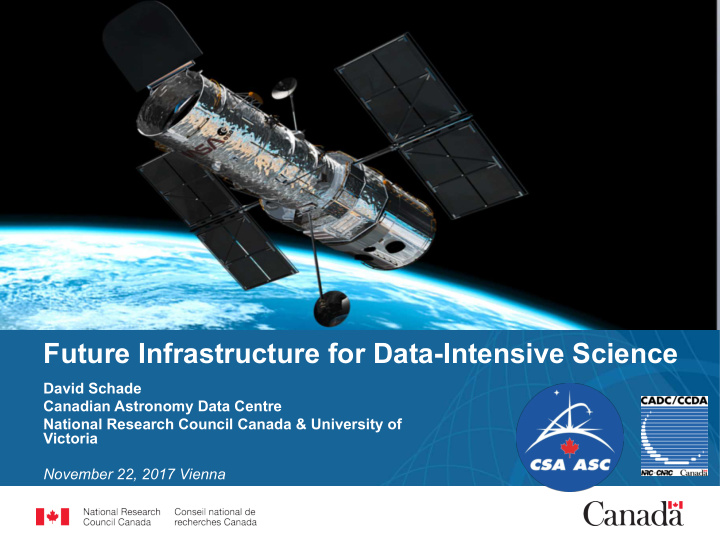



Future Infrastructure for Data-Intensive Science David Schade Canadian Astronomy Data Centre National Research Council Canada & University of Victoria November 22, 2017 Vienna
Missing recommendation The UN recognizes that governments have invested hundreds of millions of dollars to create the present- day network of astronomy data services. The powerful science capabilities provided by this network are the foundation upon which Open Universe will operate. These investments must continue and increase in order to support the types of services proposed by the Open Universe.
Fresh new ideas and approaches • Few new ideas in the Open Universe initiative • The new factor is the involvement of the UN A fresh new approach would be: A substantial transfer of the benefits of astronomy data and supporting infrastructure to the public through education, outreach, and citizen science with a focus on developing nations as the highest priority.
Scale of CADC 2016 CADC • was created in 1996 and parallels Hubble Space Telescope • has 21 staff: scientists, programmers, operations • 1 billion files • 2.6 Petabytes Data flows • 1.4 Petabytes of data out • 75 million individual calls • 300 Terabytes put back into CADC system • 15 million calls Processing • 3,671,737 jobs in batch mode • 387 interactive Virtual Machines • 460 core years of processing used
CADC data delivery
The Future: Two Themes Integration of data resources • Integration within data centres • Integration across data centres Integration of data with computing infrastructure • Integration within Canada • Integration internationally
Metadata • METADATA Integration of data from 115 instruments
ESASKY
International Data Integration • Standards • Data centre implementation
Two Themes Integration of data with computing infrastructure • Integration within Canada • Integration internationally Driven by: • Large data volumes • Government funding policy • Science practice
Past practice CADC NRC Herzberg Victoria R ESEARCHER Hubble Space Telescope Data Archive Data Storage Meta Data Users take the data home to do processing User managed User managed storage Processing
CADC operates an integrated system of resources • A cloud ecosystem for data intensive astronomy • User services • Store and share data • Create and configure VMs • Run interactive VMs • Run persistent VMs • Batch processing with VMs • Using research cloud resources • Compute Canada • CADC • Integrated authentication and authorization
Past practice CADC NRC Herzberg Victoria R ESEARCHER Hubble Space Telescope Data Archive Data Storage Meta Data Users take the data home to do processing User managed User managed storage Processing
U NIVERSITY CANFAR/CADC T ELESCOPE R ESEARCHER C LIENT C LIENT Compute Canada Compute Canada NRC Herzberg Victoria Saskatoon Victoria Archive Telescope Data Data User Interactive use Data of VMs Algorithms and S TORAGE M ANAGEMENT Software S S 2.6 PETABYTES Meta Data Queries E E M ETA D ATA M ANAGEMENT R R 8.5 TERABYTES VM V V Images I I Meta Data C C Queries Meta Data VM E E Control S S Processing Control P ROCESSING M ANAGEMENT Interactive use 954 COMPUTE CORES of VMs VM Images Processing Control Archive Data VM Service Creation and Deployment Compute Canada Compute Canada NRC Herzberg Victoria Calgary Victoria Key Data Activities • Data engineering University researchers and telescope staff have • Operations and user support privileges to upload data, create VMs and install • Software development Data In Data Out science applications, run interactive VM sessions, • Software integration # of files Terabytes # of files Terabytes submit batch processing jobs to VMs, share their • Data processing VMs, control the life-cycle for their VMs, offer • Data management Peak per day 2,169,190 8.0 648,093 16.8 software-as-a-service applications in their VMs. • User web services Avg per day 130,952 0.4 99,253 2.6 • User web interfaces Definition: VM – Virtual Machine
CADC’s role has changed radically We were: • Managers/curators/distributors of data collections We are now: • Managers of an an integrated system of services for data-intensive astronomy
Canadian distributed astronomy platform P ROCESSING S TORAGE M ETA D ATA M ANAGEMENT S TORAGE P ROCESSING S TORAGE P ROCESSING 16
Shared international platform P ROCESSING S TORAGE International Open Science Cloud
Why INTERNATIONAL shared computing platforms? Science practice is international Reciprocity • for data • for computing infrastructure • For services supporting data-intensive science
The Open Universe (whatever it turns out to be) Open Universe will be based on IVOA standards that support the operation of Astronomy Data Centres that are integrated into Open Science Clouds
Shared infrastructure for data-intensive science This new infrastructure creates opportunities for those who have limited access to resources • Equalizes access for professional scientists in developing countries • Provides new capabilities for teachers and the public Example: Graduate student in Bangladesh
Missing recommendation The UN recognizes that governments have invested hundreds of millions of dollars to create the present- day network of astronomy data services. The powerful science capabilities provided by this network are the foundation upon which Open Universe will operate. These investments must continue and increase in order to support the types of services proposed by the Open Universe.
Fresh new ideas and approach • Few new ideas in the Open Universe initiative • The new factor is the involvement of the UN A fresh new approach would be: A substantial transfer of the benefits of astronomy data and supporting infrastructure to the public through education, outreach, and citizen science with a focus on developing nations as the highest priority.
Recommend
More recommend